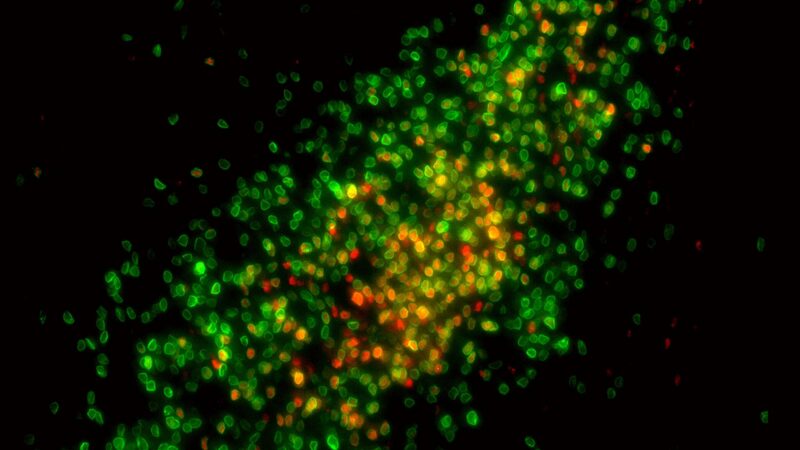
Une région du cerveau de la souris, appelée noyau de la stria terminalis, est plus grande chez les mâles que chez les femelles. De nombreux neurones (en vert) produisent le récepteur d’œstrogène. Une population spécifique de ces neurones (marquée pour une protéine appelée Nfix en rouge) est plus abondante chez les mâles que chez les femelles. Le professeur adjoint du CSHL Jessica Tollkuhn et son équipe ont identifié des gènes ciblés par les œstrogènes dans les neurones qui coordonnent les différences entre les sexes dans les circuits neuronaux. Crédit : Bruno Gegenhuber/Laboratoire Tollkuhn/CSHL, 2022
Les hormones sexuelles jouent un rôle important dans la formation du comportement d’un animal, et leur effet commence très tôt. Les poussées hormonales du début de la vie contribuent à façonner le cerveau en développement, établissant des circuits qui influenceront le comportement tout au long de la vie.
Des centaines de gènes du cerveau sont contrôlés par les hormones de croissance. œstrogène. Les fluctuations des niveaux de cette hormone provoquent des changements d’humeur, d’équilibre énergétique et de comportement tout au long de la vie, en plus de sculpter très tôt les circuits neuronaux en développement. Ces effets se produisent lorsque les récepteurs d’œstrogènes activés se situent directement sur les DNA to turn genes on or off.
Cold Spring Harbor Laboratory Assistant Professor Jessica Tollkuhn, graduate student Bruno Gegenhuber, and their colleagues, have been mapping exactly where estrogen receptors latch onto DNA inside mouse brain cells. They’ve looked at both males and females and compared the brains of adults to the still-developing brains of young pups. In a study published today (May 4, 2022) in the journal Nature, they report on the hormone receptor’s targets in the brain and show that estrogen sets up physical differences in the brains of males and females during development.
Tollkuhn explains that estrogen is present in the brains of both males and females: some neurons make it themselves out of testosterone. In male mice, estrogen generated through a surge of testosterone that is released soon after birth shapes developing circuitry. As a result, certain brain regions are larger and contain more cells in males than they do in females—a difference that affects a range of behaviors in adulthood, including mating, parenting, and aggression.
“There’s this critical period when the brain is developing and wiring up that it has to get this input in order to make these permanent changes in the brain wiring. This is a transient surge, but it seems to have extremely long-lasting effects on brain development.”
Tollkuhn’s team examined where estrogen receptors landed after this hormonal surge, focusing on a brain region called the BNST, which is larger in males than females in both mice and humans. They found a host of genes that were under estrogen’s control, including many involved in neurodevelopment and neuronal signaling. And although estrogen itself remains in the brain for only a few hours, it seems that the hormone-controlled genes remain active for weeks.
Now that they know what genes estrogen is targeting in the brain, Tollkuhn’s team plans to explore exactly how those genes mediate the hormone’s diverse effects on brain development, behavior, and disease.
Reference: “Epigenetic regulation of brain sexual differentiation by estrogen receptor alpha” 4 May 2022, Nature.
DOI: 10.1038/s41586-022-04686-1



